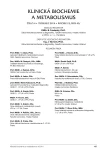Use of the protein biochip in the diagnosis of the myocardial ischemic damage
Authors:
L. Horáková 1; R. Pudil 1; M. Vašatová 2; M. Tichý 2
Authors‘ workplace:
I. Interní kardioangiologická klinika, Fakultní nemocnice a Lékařská fakulta v Hradci Králové, Univerzita Karlova v Praze, Česká republika
1; Ústav klinické biochemie a diagnostiky, Fakultní nemocnice a Lékařská fakulta v Hradci Králové, Univerzita Karlova v Praze, Česká republika
2
Published in:
Klin. Biochem. Metab., 22 (43), 2014, No. 4, p. 203-207
Overview
Objective:
This study observes patients with acute coronary syndromes. To the diagnosis of acute myocardial infarction (AIM) we use the new proteins biochip technologies. The aim of this study is to evaluate the new strategy of laboratory diagnostic method and to confront the less known’s cardio markers with the standard markers and with the clinical parameters.
Material and methods:
This study contains 44 patients with AIM and the blood samples were taken in the time of the admission, 24 hours later and then the fourth or fifth day of hospitalization. We tested the cardiac panel Cardiac Array (cTnI, CK MB, myoglobin, CAIII, FABP and GPBB) on the biochip analyser The Evidence InvestigatorTM from Randox (Randox Laboratories Ltd., United Kingdom).
Results:
Our study confirms the close relationship between FABP and GPBB to AIM and we can consider these markers as early markers in the diagnosis of AIM. FABP has, as the standard markers CKMB or TnI, the prognostic value too (the higher values are associated with the systolic dysfunction). This study employs a new strategy of the biochip analyser in the diagnosis of AIM (in the same time we have the concentrations of more parameters and complex information about AIM).
Conclusion:
This method presents new interesting multianalytes approach to the diagnosis of the AIM. But this method requires a lot of further studies to verify this technology.
Keywords:
acute myocardial infarction, protein biochip, cardiac markers, systolic dysfunction.
Sources
1. Vojáček, J. et al. Third universal definition of myocardial infarction. Cor ev Vasa, 2013, vol. 55, p. 228-235.
2. Vaananen, H. K. et al. Serum carbonic anhydrase III and myoglobin concentrations in acute myocardial infarction. Clin. Chem., 1990, vol. 36, no. 4, p. 635-638.
3. Beuerle, J. R. et al. Characteristics of myoglobin, carbonic anhydrase III and the myoglobin/carbonic anhydrase III ratio in trauma, exercise, and myocardial infarction patients. Clin. Chim. Acta, 2000, 294, p. 115-128.
4. Rabitzsch, G. et al. Immunoenzymometric assay of human glycogen phosphorylase isoenzyme BB in diagnosis of ischemic myocardial injury. Clin. Chem., 1995, 41/7, p. 966-978.
5. Ulrychová, M., Tichý, M., Horáček, J. M. et al. Multianalytový přístup k diagnostice srdečních chorob technologií proteinových biočipů. Čas. Lék. čes., 2009, 148, p. 591-596.
6. Kim, K. S. et al. Heart-type fatty acid-binding protein as an adjunct to cardiac Troponin-I for the diagnosis of myocardial infarction. J. Korean Med. Sci., 2011, 26, p. 47-52.
7. Cavus, U. et al. Heart-type fatty acid binding protein can be a diagnostic marker in acute coronary syndromes. Journal of the national medical association, 2006, vol. 98, no. 7, p. 1067-1070.
8. Ishii, J. et al. Prognostic value of serum concentration of heart-type fatty acid-binding protein relative to cardiac Troponin T on admission in the early hours of acute coronary syndrome. Clin. Chem., 2005, p. 1397-1404.
9. O´Donoghue, M. et al. Prognostic utility of heart-type fatty acid binding protein in patients with acute coronary syndromes. Circulation, 2006, 114, p. 550-557.
10. Di Serio, F. et al. Proteomic approach to the diagnosis of acute coronary syndrome: Preliminary results. Clin. Chim. Acta, 2005, 357, p. 226-235.
11. Randox Laboratories, Ltd. Evidence investigatorTM, Cardiac Array Cat No. EV3511, United Kingdom
Labels
Clinical biochemistry Nuclear medicine Nutritive therapistArticle was published in
Clinical Biochemistry and Metabolism

2014 Issue 4
Most read in this issue
- Refeeding syndrome – pathobiochemistry, electrolyte dysbalances and their correction
- Role of oxidative stress in Alzheimer´s disease and related consequences
- Liver Iron and Copper Assessment in Bioptic Material from Patients with Different Hepatic Pathology – Diagnostic Significance and Relationship to Serum Iron and Copper Parameters
- Harmonization, standardization, metrologic, succession in 2014. Principles, importance and data.
